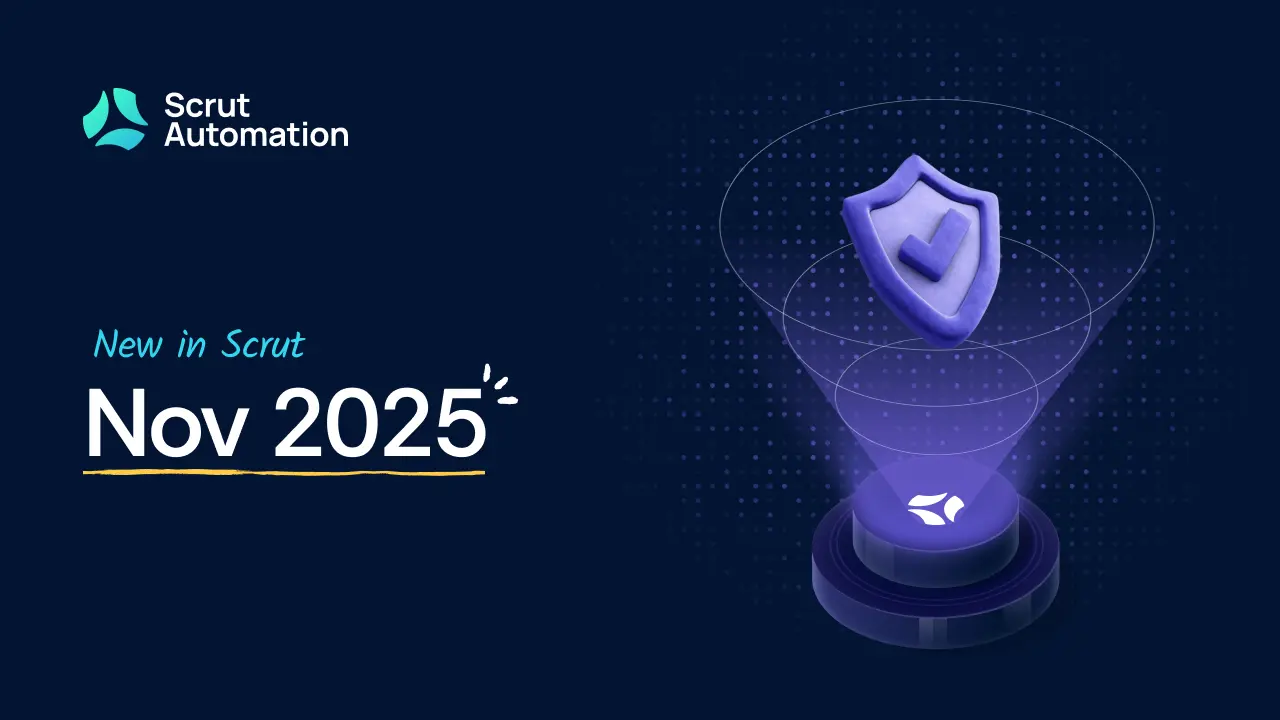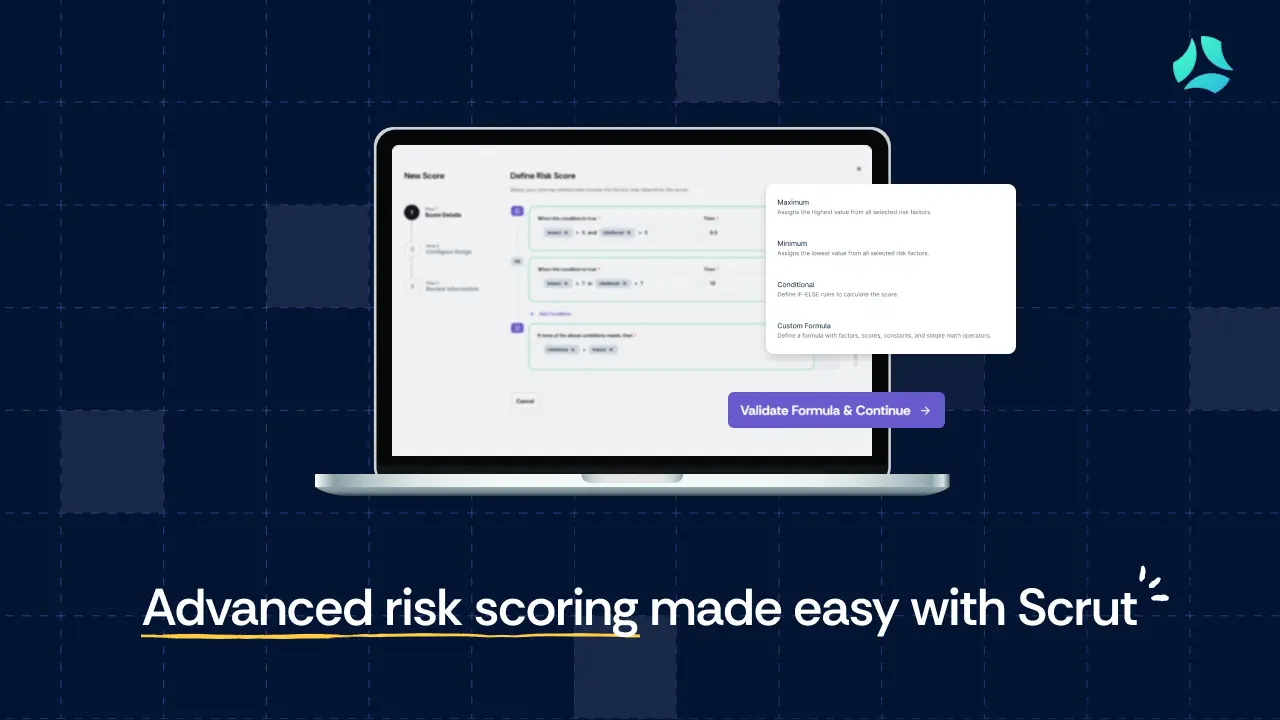Top 7 compliance management software for 2025

With regulatory requirements evolving too frequently across geographies and industries, modern businesses must comply with many industry frameworks, from SOC 2 and ISO 27001 to GDPR and HIPAA.
But here’s the problem—many still rely on manual efforts like spreadsheets, siloed documentation, and manual workflows to manage it all. According to a compliance trends report, 40% of compliance teams still use spreadsheets, while only 38% have adopted regulatory technology (RegTech).
This means compliance teams are constantly on the run: organizing evidence, reviewing and updating policies, juggling risks, and scrambling during audits.
Thankfully, there is a smarter way to manage it all: compliance management software.
With the right compliance software in your tech stack, you can ensure seamless compliance by automating the entire lifecycle, from risk assessments and control mapping to real-time monitoring and audit readiness.
However, choosing the right solution can be overwhelming with so many options to consider. But don’t worry—we’ve conducted in-depth research and compiled a list of the top seven compliance management software for you.
Key features of a good compliance management solution
Before you choose the right compliance management solution, it’s important to understand what actually matters for your compliance and risk management needs, especially if you're aiming for continuous compliance, fast audits, and minimal manual overhead. Here are the must-have features for your compliance platform:
1. User-friendly dashboards
A visual representation of the real-time status of the compliance posture of your organization is a must-have feature. Having dedicated dashboards for different modules, such as risk, compliance, audit, and people, provides a comprehensive view of pending and overdue risk and compliance tasks. They also enable quick decision-making and accelerated audit preparation.
Additionally, the dashboards must go beyond a basic overview by offering granular insights. They should feature:
- Advanced filtering options to segment compliance data by framework, department, or progress status, enabling targeted analysis of specific areas
- Metric-based graphs that display critical indicators, including risk controls status, compliance task completion, and audit progress.
- Jobs to be done views (pending and overdue indicators) with highlights for upcoming audits and deadlines, ensuring timely action and preparedness.
2. Policy management
Building compliance policies for multiple frameworks from scratch is a lengthy, resource-intensive, and complicated process. However, good compliance management software should come with pre-built, customizable policy templates that you can use out of the box to quickly create, update, and enforce data processing, privacy, and cybersecurity policies.
This streamlines the entire policy lifecycle and enables you to save time, maintain consistency across frameworks, ensure continuous compliance, and avoid legal issues.
Here’s what your compliance management software should provide in its policy module:
- Pre-built, customizable policy templates aligned with various regulations.
- A centralized policy repository with version control.
- Automated policy distribution with employee acceptance tracking.
- Simplified workflows for managing policy approvals and exceptions.
3. Continuous compliance monitoring via automated tests
Compliance isn’t static—controls can break, fail silently, or be bypassed. Your platform should proactively monitor and test controls on a recurring basis to ensure they’re functioning as intended. Look out for these core capabilities:
- Automated control testing based on predefined logic (e.g., checking if MFA is enabled, or if access logs are collected).
- Real-time monitoring of control status and evidence freshness.
- Automatic or scheduled alerts for failed controls, missing evidence, or policy changes sent to specified owners.
- Built-in remediation workflows that suggest remediation steps and enable task assigning and tracking corrective actions.
4. Multi-framework compliance support
Most organizations pursue a mix of certifications and regulatory compliance—like SOC 2, ISO 27001, GDPR, HIPAA, and PCI DSS. Without centralized management, compliance becomes fragmented and redundant. Ensure your compliance platform:
- Supports prebuilt, up-to-date templates for major frameworks.
- Lets you map one control to multiple frameworks.
- Surfaces overlapping control, testing, and documentation requirements to reduce duplicated effort.
- Tracks test and evidence reuse across frameworks.
- Allows exceptions and deviation handling per framework with documented rationale.
5. Integrated risk assessment and mitigation
Risk isn’t separate from compliance—it’s central to it. Organizations often struggle with numerous risks, such as IT, operational, compliance, legal, reputational, HR, third-party, and more. Manually identifying and managing these risks leads to inefficiencies, errors, and several undetected risks.
Your platform should provide centralized visibility into internal, vendor, and environmental risks, and tightly connect those risks to your controls. Moreover, since third-party risks have become one of the biggest concerns for businesses due to extensive interconnectedness, your software should include streamlined workflows to assess and monitor risks related to business partners, service providers, contractors, R&D partners, affiliates, and other external entities that access your systems and data.
Key features to look out for in a risk module are:
- A central, structured risk register with a pre-built risk library that includes standard third-party risk categories and fields for capturing vendor-specific information.
- Real-time dashboards and heat maps for risk status, trends, and ownership, with filters to view risks associated with vendor and third-party entities.
- Customizable and pre-built templates for risk assessments and scoring.
- Risk-based prioritization of control testing and mitigation, including alerts for critical third-party risks that have a high impact on organizational security.
- Configurable workflows for risk acceptance, remediation, and transfer.
The software also enables you to map identified risks to specific controls within multiple frameworks, streamlining cross-framework compliance processes and audit reporting.
Learn how to manage enterprise risk effectively with our Unlocking the Power of Enterprise Risk Management ebook.
6. Integrations with existing tech stack
A key requirement in compliance management software is its ability to integrate with internal and third-party security tools to actively evaluate security controls against compliance requirements and gain real-time insights into compliance health.
These integrations, usually achieved through APIs, allow the software to pull security data from tools like security information and event management (SIEM), vulnerability scanners, and access management platforms. This data can be further used to map risks to controls and controls to compliance requirements, enabling recurring controls testing and automated mitigation workflows.
For instance, connecting your log monitoring tools shouldn’t just show you logs; rather, it should use them to automatically verify the effectiveness of access controls. Similarly, integration with vulnerability scanners shouldn’t only detect weaknesses but also map them to affected controls, providing clear visibility into both security and compliance risks. This enables you to gain an up-to-date perspective of your organization’s compliance health and employ more strategic remediation efforts.
7. Audit readiness and real-time reporting
Every audit cycle brings the same fire drill—gathering evidence, tracking ownership, and generating reports to prove ongoing compliance. A modern platform should provide real-time insights into compliance status and keep you perpetually audit-ready.
That’s why, when it comes to audit-readiness and real-time reporting, look out for these features:
- Real-time dashboards showing control status, evidence freshness, and test results.
- Downloadable reports mapped to frameworks or specific controls.
- Role-based access for auditors, external reviewers, or internal stakeholders.
- Automated workflows for control owners and reviewers.
- Full access logs and change history for every item.
8. Automated evidence collection
Manual evidence collection—from screenshots and logs to change records—is one of the biggest time sinks during audits. A modern platform should automate this process end-to-end, making your compliance audits faster and less stressful.
Look for solutions that:
- Integrate with your core tech systems (CRM, HRIS, IT tools, cloud apps, finance platforms) via secure APIs.
- Capture evidence on a real-time or scheduled basis.
- Map collected evidence directly to controls across frameworks.
- Maintain timestamped audit trails for all evidence submissions.
Best compliance management software in 2025: An overview
Top 7 compliance management software for 2025
1. Scrut
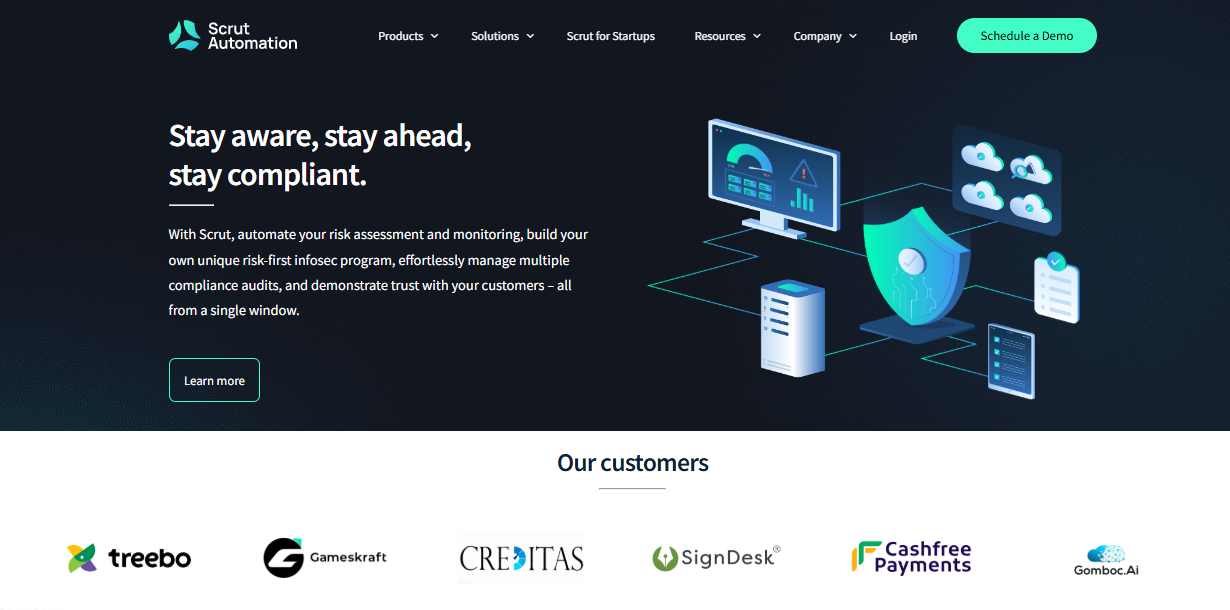
Scrut is the leading, all-in-one governance, risk, and compliance (GRC) platform trusted by 1300+ businesses worldwide. Built for growing and busy teams, Scrut provides a broad range of compliance management features, making it the most customizable solution that helps any business easily build, onboard, and manage an effective compliance program among businesses of all sizes.
Scrut offers all the essential features businesses need to efficiently manage their compliance programs within a single-window platform. Scrut helps you eliminate manual, spreadsheet-driven processes by centralizing everything—from real-time monitoring and risk management to an auditor portal—in one intuitive platform.
With automated workflows and real-time insights, Scrut enables you to be risk-aware at all times while ensuring that your teams spend as little time and effort as possible on these manual compliance tasks.
Key features and benefits
- Continuous controls monitoring and testing: Scrut performs daily automated tests across compliance artifacts and internal controls within your cloud infrastructure, testing against over 230 CIS benchmarks. Scrut lets you track control effectiveness in real time, identify risks and misconfigurations, assign remediation tasks, track status, and send alerts to specified owners.
- Policy templates with an in-line editor: Leverage Scrut’s robust library of 75+ customizable policy templates vetted by industry experts and leading auditors, complete with version control using an in-line policy editor. This facilitates the easy creation and implementation of compliance-ready policies, reducing the time and effort required to build from scratch. Moreover, Scrut’s platform maps the policies to relevant controls within multiple frameworks to streamline cross-framework compliance and audit preparation efforts.
- Automated evidence extraction with integrations: Connect Scrut to 100+ popular applications—including HRIS, IT, and cloud tools—to automatically collect, map to controls, and centralize evidence. This saves up to 80% of the manual effort involved in collecting documentation and ensures that the evidence is current and accurate.
- Multi-framework support: Whether you’re working toward SOC 2, ISO 27001, GDPR, HIPAA, or PCI DSS, Scrut supports 50+ frameworks out of the box and also custom frameworks. It allows you to manage multiple audits in parallel with pre-mapped unified controls, pre-built templates, automated monitoring, and centralized progress dashboards.
- Audit management: Use Scrut’s Audit Center with a centralized audit dashboard to facilitate access-based views and improved collaboration with auditors through requests and findings trackers. Use intuitive workflows to identify log risks from auditor findings and initiate mitigation tasks. Scrut also enables automated report generation to eliminate cumbersome paperwork and track compliance status in real time, simplifying audit preparation.
- Risk register and dashboard: Manage internal, vendor, and cloud-related risks from a centralized risk register. Log risks manually or import them from scans and spreadsheets, assign severity scores, and visualize them through intuitive heatmaps, charts, and trends to guide mitigation decisions.
- Simplified risk workflows: Automate risk mapping to policies, procedures, and controls that must be implemented or updated to ensure compliance. Choose a risk treatment strategy and assign platform-generated mitigation steps to the right persons with multi-level approvals to close risks quickly. This ensures no risk goes unnoticed while also recording detailed logs for audits.

Here’s what Deep Shah, Airpay’s Technology Manager, says about Scrut:

Pros
- Hands-on support, from onboarding to audit, by experts with 50+ years of combined InfoSec experience.
- Trusted by 1,300+ customers across industries worldwide.
- Open to customization and integration requests.
- Visual, real-time, and drill-down dashboards across all modules
Cons
- Complements, but doesn’t replace, your entire security stack. Scrut is best used alongside your existing security-only tools.
Pricing
Scrut offers the best custom pricing to serve businesses of all sizes. Contact the team to obtain a quote or schedule a demo.
2. Vanta
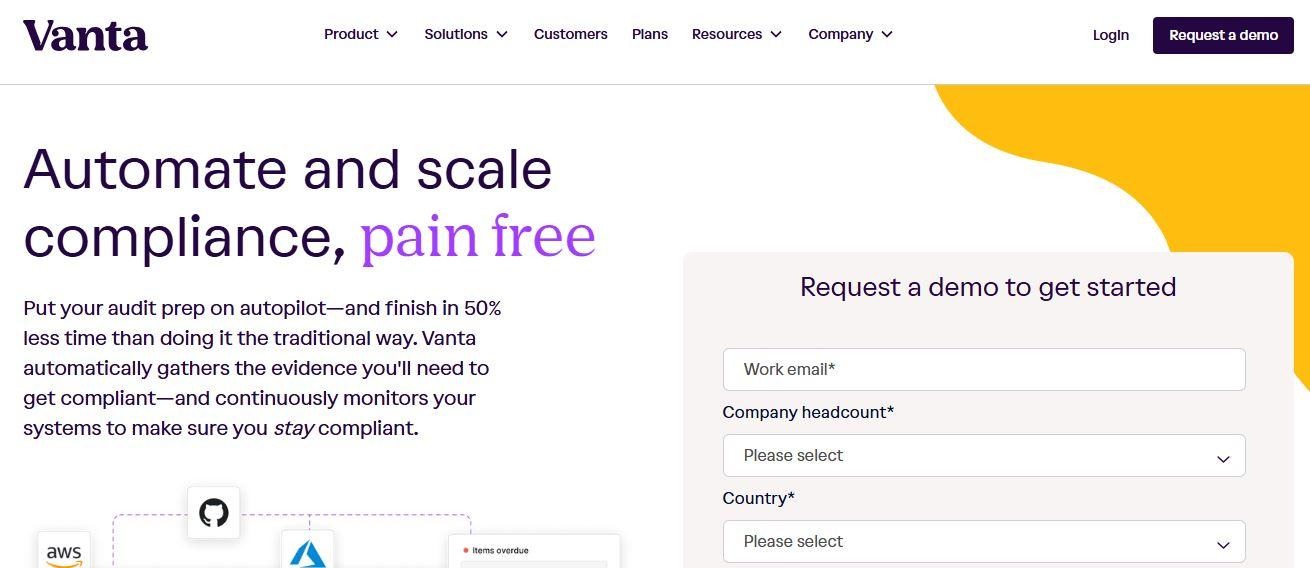
Vanta is a security and compliance automation platform that enables businesses to efficiently manage compliance and streamline audit preparation for InfoSec frameworks like ISO 27001, SOC 2, HIPAA, and GDPR.
It offers automation for key compliance management processes, such as evidence gathering, compliance monitoring, and reporting.
Key features
- Real-time insights: Gain enhanced visibility into your compliance posture by automating evidence collection through multiple integrations with applications like GitHub, Google Workspace, and AWS.
- Customizable policy templates: Leverage its pre-built policies and a policy builder to customize your internal compliance policies, simplifying policy generation and management.
- Audit management: Centralize compliance evidence in a single place to demonstrate audit readiness and facilitate improved collaboration with auditors.
Pros
- Provides real-time security monitoring and automated compliance checks to ensure adherence to regulations.
Cons
- Limited framework support compared to other multi-framework solutions.
Pricing
Vanta offers two plans, Core and Plus, for startups and three plans, Growth, Scale, and Enterprise, for GRC teams. Visit their website to request a demo and get custom pricing.
3. Drata
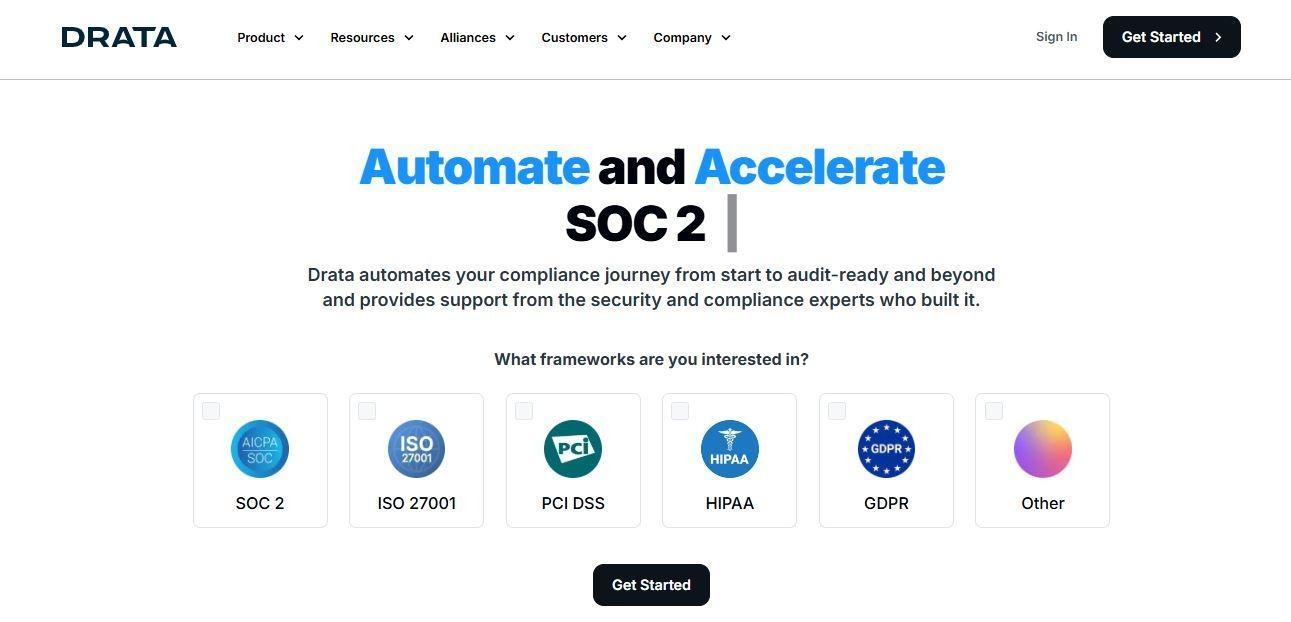
Drata is an automated compliance platform that streamlines compliance workflows and ensures audit readiness. It helps businesses continuously monitor controls, gather evidence with multiple integrations, and track compliance status in real time.
Key features
- Policy and control libraries: Get access to pre-built policies and controls that are customizable according to your business needs.
- Security reports: Auto-generate and share security reports with relevant stakeholders to demonstrate your organization’s security and compliance posture.
- Centralized platform: Simplify compliance management with a user-friendly, single-window platform that enables you to manage evidence, controls, and reports in one place.
Pros
- Provides user-friendly compliance management software with excellent customer support.
Cons
- Requires more customization within certain key features and processes.
Pricing
Drata provides custom pricing quotes on request. Contact their sales team to request a demo and for further information.
4. Sprinto

Sprinto is user-friendly compliance management software that integrates risk management and security testing with automated compliance workflows. It integrates with cloud applications to identify risks, map them to controls, and run automated control tests, all within a single platform.
Key features
- Automated compliance workflows: Reduce time and manual efforts required to become audit-ready with automated compliance tasks, such as control verification and gap mitigation.
- Artifact mapping: Automatically map your company’s policies and controls to framework requirements and gather evidence with multiple integrations to streamline the audit process and ensure business operations are aligned with industry regulations.
- Multi-framework support: Scale your compliance program with Sprinto’s support for the most popular data security and privacy frameworks and efficiently manage parallel audits.
Pros
- Simplifies complex tasks with automated workflows and integrates well with business systems.
Cons
- Requires more customization options to meet unique business needs.
Pricing
Contact Sprinto’s team to book a personal demo and obtain custom pricing quotes.
5. OneTrust

OneTrust is a compliance management software focusing on data privacy and security compliance with standard industry regulations like SOC 2, HIPAA, and GDPR. It helps businesses simplify risk management, automate regulatory compliance, and maintain audit readiness.
Key features
- Out-of-the-box templates: Access comprehensive policy, control, and audit templates designed to support various frameworks and regulations.
- Automated evidence collection: Integrate with other business systems to automatically gather evidence in real time and store it in a single place to streamline the audit process.
- Evidence mapping: Automate mapping compliance evidence to control requirements, eliminating the need to manually link each piece of evidence to the framework’s or standard’s requirements.
Pros
- Supports multiple compliance frameworks and offers robust data privacy management tools.
Cons
- Requires a steep learning curve and technical know-how to deploy integrations.
Pricing
OneTrust provides customized pricing based on admin users and asset inventory. Contact OneTrust’s team to request a demo and get a pricing quote suitable for your unique compliance needs.
6. AuditBoard
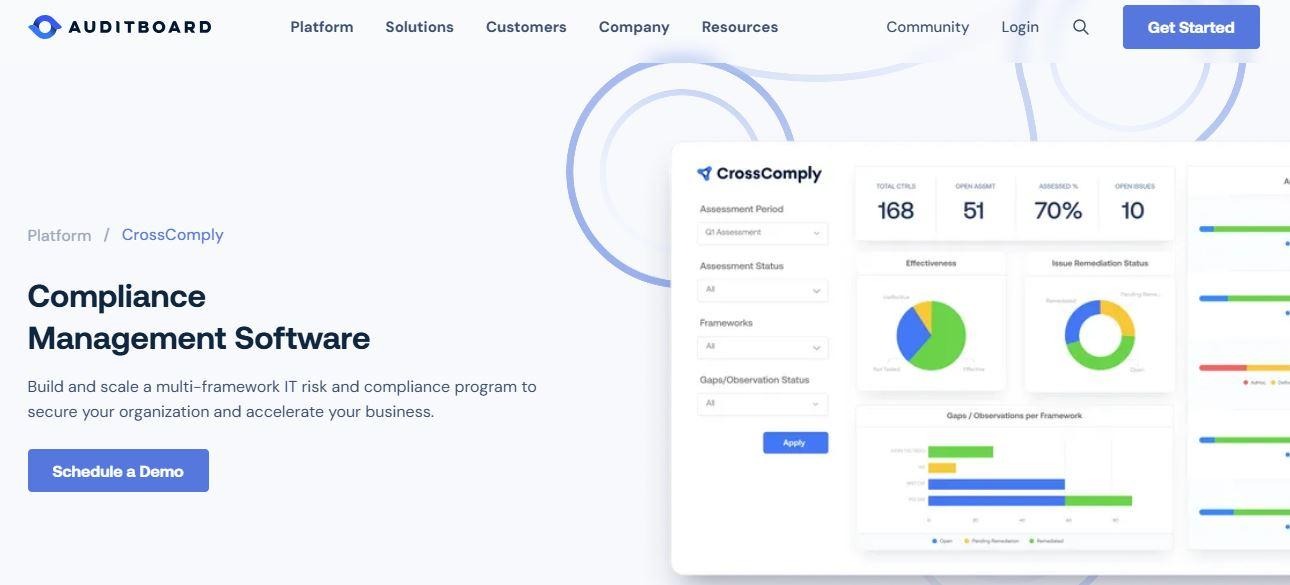
AuditBoard offers cloud-based audit and compliance management software that streamlines internal audits by automating key processes. Its simplified risk and compliance workflows enable proactive compliance gap remediation and strengthen your organization’s security and compliance posture.
Key features
- Automated compliance tasks: Reduce manual efforts by automating evidence collection, gap assessments, and remediation recommendations for multiple frameworks. Eliminate redundant tasks and free your compliance team to perform more strategic activities.
- Automated mapping: Accelerate the compliance process and simplify audit preparation with automated suggestions for mapping risks, controls, and requirements.
- Audit reporting: Streamline the generation of fixed and real-time audit reports with customization options to gain enhanced visibility into compliance status and make data-driven decisions.
Pros
- Offers an easy-to-use interface with intuitive workflows that enhance customer experience.
Cons
- Requires paying separately for different modules, raising the overall cost of implementation.
Pricing
Schedule a demo and get custom pricing quotes based on your organization's size and compliance requirements.
7. Hyperproof

Hyperproof is a security compliance automation platform that helps businesses streamline end-to-end compliance processes with integrated risk management. It enables you to manage compliance for several frameworks through a single window platform.
Key features
- Evidence collection: Relieve your compliance and audit teams of repetitive tasks by automatically collecting evidence that can be mapped and reused across multiple industry frameworks.
- Risk mitigation workflows: Address risks quickly by assigning work with auto-suggested remediation steps. Formulate risk treatment strategies by easily linking risks to controls.
- Audit reporting: Leverage a centralized dashboard to automatically generate real-time reports that stakeholders can use to understand your compliance and audit readiness. It also helps you promptly act on audit findings to resolve compliance gaps.
Pros
- Offers an easy-to-implement solution with admirable customer support.
Cons
- Provides limited customization options in the dashboard and internal reporting features.
Pricing
Contact their sales team directly to request a demo and get custom pricing quotes for your unique business needs.
Eliminate compliance hassles with Scrut’s automated compliance management
Data privacy and protection regulations are becoming increasingly stringent each year.
However, achieving and maintaining compliance with multiple frameworks becomes challenging if your business relies on inefficient, resource-heavy, unreliable, and unscalable manual processes. They can lead to missed risks, non-compliance, failed audits, lawsuits, fines, and damaged credibility.
That’s where Scrut stands out with powerful automation features and easy integrations that accelerate your compliance journey and ensure audit readiness.
Over and above the capabilities we discussed earlier, Scrut offers professional white-glove service with security and compliance experts assisting you at every step of your compliance journey, going beyond mere automation.
These experts guide you with strategic insights and provide hands-on support for key functions, including:
- Policy creation and customization for unique business needs, ensuring alignment with industry standards.
- Client onboarding and support with an understanding of unique client requirements.
- Vendor risk assessments require nuanced interpretations and expert judgments.
- Designing compliance workflows based on organizational structures and specific regulatory requirements.
- Internal audit assistance with analysis of audit findings and resolving cumbersome compliance issues.
- Access and collaboration with a global auditor network, along with support during audits.
Unlike rigid, one-size-fits-all solutions, Scrut understands that compliance needs are rarely uniform—the compliance journey for a startup will naturally differ from that of a mid-market player. That’s why Scrut is engineered for deep customizations, providing a personalized client experience to ensure all your compliance obligations are thoroughly addressed, regardless of your company’s size or stage.
That’s not all; most existing users see Scrut’s platform as a cost-effective solution for compliance management, leading to a lower total cost of ownership. Many clients even highlight that its pricing is significantly lower compared to other compliance platforms, especially for SaaS companies.
Schedule a demo with us today to see the full potential of Scrut’s compliance automation platform in action.
Additional resources: Future-proof your GRC strategies with our ebook on the Top 10 GRC and AI Predictions for 2025.
FAQs
1. How does Scrut help manage risks for businesses heavily associated with third-party vendors?
Scrut’s automated compliance management software features a dedicated vendor module for effectively managing vendor-related risks. It enables you to streamline vendor evaluations with assessment templates and a questionnaire builder, continuously monitor vendor compliance, and enhance collaboration through a dedicated vendor portal.
Additionally, the integrated risk module allows you to register all inherent and residual vendor risks with customizable scores, assign mitigation tasks to owners, and track progress, all from a single window.
2. Does Scrut offer compliance and audit support for small to mid-sized businesses that lack adequate expertise?
Yes, Scrut offers professional white-glove support from experts who assist you with risk and compliance gap remediation. This includes guidance on control implementation, evidence preparation, and assistance during external audits. Scrut also offers pre-built, customizable policy templates approved by industry experts and leading auditors to streamline and accelerate your compliance journey.



